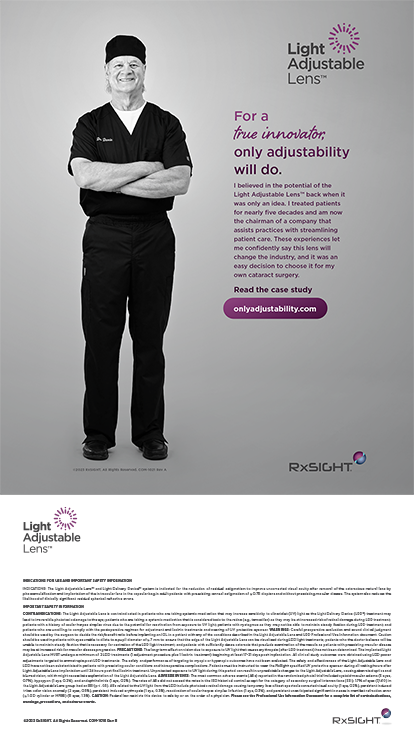

A Novel Intraocular Lens Simulator That Allows Patients to Experience the World Through Multifocal Intraocular Lenses Before Surgeries
Na KS, Kim SJ, Nam G, et al1
Industry support: None
ABSTRACT SUMMARY
A prospective study evaluated whether a device could simulate patients’ vision through multifocal IOLs by allowing them to view distant and near objects through the IOL simulator. The study included 20 eyes of 20 patients with a cataract in at least one eye that was not blocking the visual axis. Patients were 50 to 70 years of age, and their BCVA was better than 0.1 logMAR.
The IOL simulator consisted of a trial lens frame adapter, a lens tube, a concave lens, a spacer, a wet cell, and an IOL, and it was mounted on a trial lens frame. Two IOL types were used in the study: a Tecnis Monofocal 1-Piece (model ZCB00, Johnson & Johnson Vision) and a Tecnis Multifocal IOL +3.25 D add (model ZLB00, Johnson & Johnson Vision).
Study in Brief
In a prospective study, an experimental simulator appeared to be able to show patients how they would view their surroundings with different IOLs.
Why it Matters
Every IOL has advantages and disadvantages. The ability to experience vision with potential lenses before cataract or refractive lens exchange surgery would allow patients to make more informed decisions.
While wearing a trial lens frame with an IOL simulator on distance-corrected lenses, patients underwent tests of the defocus curve, their satisfaction with their distance and near vision, halos around light, and near point accommodation. The tests were performed with both the monofocal and multifocal IOL. Satisfaction and halos were subjective scores. A machine vision lens and a scientific camera were attached to the simulator to determine how the world looked to patients through the simulator, and far and near objects were photographed.
When the defocus curves were examined, patients’ visual acuity was greatest at 0 D with the monofocal IOL and then decreased continuously. With a multifocal IOL, their visual acuity was also greatest at 0 D but peaked again at -4.00 D and then decreased. Patients were slightly more satisfied with their distance vision, experienced fewer halos, and had greater near point accommodation with the monofocal IOL. Their satisfaction with their near vision was greater with the multifocal IOL. Scientific camera test results were compatible with these data.
DISCUSSION
Multifocal and extended depth of focus (EDOF) IOLs can provide patients with spectacle independence. Surgeons do their best to describe the advantages and disadvantages of different IOL designs to patients preoperatively. Nothing, however, is more effective than for people to see the pros and cons with their own eyes. A system that uses IOLs to simulate vision could therefore be helpful to surgeons and patients.
The simulator developed by Na and colleagues is experimental and the first device that enables patients to test far and near vision with an IOL before surgery. The device could thus facilitate monofocal and multifocal IOL selection.
Similar simulators have been tried.2,3 Their use of a convex lens, however, reversed the image and made it difficult for patients to move with the simulator and perceive their surroundings. The devices were impractical because they were immobile and a true multifocal IOL could not be placed.4,5
The patient must hold the simulator designed by Na and colleagues, and space may exist between the trial frame and the eye. Results appeared to be compatible with real life.
Visual Outcomes of a New Nondiffractive Extended Depth-Of-Focus Intraocular Lens Targeted for Minimonovision: 3-Month Results of a Prospective Cohort Study
van Amelsfort T, Webers VSC, Bauer NJC, et al6
Industry support: None
ABSTRACT SUMMARY
A prospective case series evaluated visual outcomes, spectacle independence, and optical phenomena after the bilateral implantation of a nondiffractive EDOF IOL targeted for mini-monovision. The study included 44 eyes of 22 patients with age-related cataracts.
Patients received an AcrySof IQ Vivity IOL (Alcon) in each eye. IOL power calculations were performed with the IOLMaster (Carl Zeiss Meditec) and Barrett Universal II formula. Refractive targets of near emmetropia and between -0.25 and -0.50 D were used for the dominant and nondominant eyes, respectively.
Study in Brief
A prospective case series evaluated visual outcomes, spectacle independence, and optical phenomena after the bilateral implantation of a nondiffractive extended depth of focus (EDOF) IOL using a mini-monovision strategy. Patients achieved good distance and intermediate visual acuity, functional near visual acuity, and high levels of satisfaction and spectacle independence.
Why it Matters
EDOF IOLs can provide patients with a wider range of UCVA, particularly intermediate to distance visual acuity, compared to monofocal IOLs but with fewer unwanted photic phenomena than with multifocal IOLs. Strategies that enhance refractive outcomes with EDOF IOLs could improve patient satisfaction by further reducing their spectacle dependence while maintaining their quality of vision.
Three months after surgery, patients’ manifest refraction, monocular and binocular corrected and uncorrected distance visual acuity, and binocular corrected and uncorrected intermediate and near visual acuity were assessed. Uncorrected monocular/binocular and distance-corrected binocular defocus curves, spectacle independence, optical phenomena such as glare and halos, and patient satisfaction were also evaluated.
The mean refractive spherical equivalent of the dominant and nondominant eyes was 0.11 ±0.31 and -0.13 ±0.30 D, respectively. The mean binocular uncorrected distance visual acuity, uncorrected intermediate visual acuity, and uncorrected near visual acuity were -0.07 ±0.10, 0.04 ±0.09, and 0.23 ±0.12 logMAR, respectively. The binocular defocus curve was better than 0.10 logMAR over a range of -2.00 to +0.50 D. The percentage of patients who reported not or rarely wearing spectacles for distance, intermediate, and near vision was 96%, 68%, and 38%, respectively. The percentage of patients who experienced no halos, glare, or starbursts was 91%, 91%, and 100%, respectively.
DISCUSSION
Patients generally prefer to wear glasses as infrequently as possible after cataract surgery. The implantation of multifocal IOLs can reduce their need for glasses for distance and near vision. They may be disturbed, however, by halos and glare and a reduction in contrast sensitivity after surgery. If photic problems persist for a long time, some patients may require IOL explantation.7,8 Moreover, because of the potential reduction in postoperative quality of vision, multifocal IOLs are contraindicated for patients with preexisting problems related to the visual pathway.9,10
EDOF IOLs are a potential alternative. They can provide patients with a wider field (from intermediate to distance) of uncorrected vision compared to monofocal IOLs and reduce their dependence on spectacles. EDOF IOLs are also associated with fewer dysphotopsias than multifocal IOLs.11
In the study by van Amelsfort et al,6 mild myopia was targeted in the nondominant eye. Patients’ distance visual acuity was better but their intermediate and near visual acuity was similar compared to if emmetropia had been the target (based on data from FDA premarket approval trials).11 The mini-monovision strategy also produced greater spectacle independence and caused fewer optical phenomena.
The amount of myopia achieved in the nondominant eyes was less than planned in the study by van Amelsfort et al.6 The dominant eyes had mild hyperopia postoperatively. The postoperative mean refractive spherical equivalent was 0.11 and -0.13 D in the dominant and nondominant eyes, respectively. This may explain why near visual acuity was not superior with mini-monovision compared to results with bilateral emmetropia reported in US premarket FDA approval trials.11
1. Na KS, Kim SJ, Nam G, et al. A novel intraocular lens simulator that allows patients to experience the world through multifocal intraocular lenses before surgeries. Transl Vis Sci Technol. 2022;11(3):14.
2. Wahl S, Song C, Ohlendorf A. Comparison of two devices to simulate vision with intraocular lenses. Clin Ophthalmol. 2019;13:123-130.
3. Kusel R, Rassow B. Preoperative assessment of intraocular lens corrected vision. Article in German. Klin Monbl Augenheilkd. 1999;215(2):127-131.
4. Kaymak H, Graff B, Nienhaus S, et al. Selection of intraocular lenses for patients with maculopathies. Article in German. Klin Monbl Augenheilkd. 2020;237(7):894- 902.
5. Akondi V, Sawides L, Marrakchi Y, Gambra E, Marcos S, Dorronsoro C. Experimental validations of a tunable-lens-based visual demonstrator of multifocal corrections. Biomed Opt Express. 2018;9(12):6302-6317.
6. van Amelsfort T, Webers VSC, Bauer NJC, et al. Visual outcomes of a new nondiffractive extended depth-of-focus intraocular lens targeted for minimonovision: 3-month results of a prospective cohort study. J Cataract Refract Surg. 2022;48(2):151-156.
7. Alio JL, Plaza-Puche AB, Férnandez-Buenaga R, Pikkel J, Maldonado M. Multifocal intraocular lenses: an overview. Surv Ophthalmol. 2017;62(5):611-634.
8. Erie JC, Simpson MJ, Bandhauer MH. A modified intraocular lens design to reduce negative dysphotopsia. J Cataract Refract Surg. 2019;45(7):1013-1019.
9. Jonker SMR, Bauer NJC, Makhotkina NY, Berendschot TT, van den Biggelaar FJ, Nuijts RM. Comparison of a trifocal intraocular lens with a +3.0 D bifocal IOL: results of a prospective randomized clinical trial. J Cataract Refract Surg. 2015;41(8):1631-1640.
10. de Vries NE, Nuijts RMMA. Multifocal intraocular lenses in cataract surgery: literature review of benefits and side effects. J Cataract Refract Surg. 2013;39(2):268-278.
11. Schallhorn JM. Multifocal and extended depth of focus intraocular lenses: a comparison of data from the United States Food and Drug Administration premarket approval trials. J Refract Surg. 2021;37(2):98-104.




